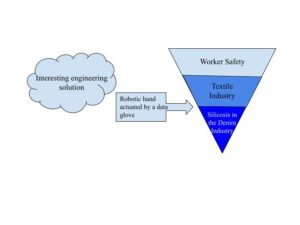Problem Statement:
To aid in creating protective manufacturing equipment: specifically in providing an alternative to direct contact of human hands in the denim industry and eliminating exposure to sandblasters, while still benefiting from skilled labor that cannot be replicated by a fully autonomous process.
Problem Selection and Motivation:
The team sought to create an exciting new product that would both be fun to work on, and serve a purpose that could benefit society. Our initial concept generation process focused mostly on interesting engineering solutions without consideration for what problems these could help solve. As a result the team decided on creating a robotic hand actuated by a data glove, and had to later backtrack and consider what types of problems this form of automation would help solve. We initially settled on the textile industry as a whole, as our background research indicated it was rife with worker safety issues. Looking at the textile industry as a whole was challenging, because it was difficult to narrow down the parameters we would need to set for our prototype. So the team dove deeper into researching worker safety issues in the textile industry, eventually landing on a serious and fatal issue surrounding denim manufacturing: silicosis from sandblasting. Picking a more narrowly focused problem allowed the team to create logical specifications for our prototype that were based on the problem we were trying to solve. Silicosis is a problem that has far reaching consequences for workers, and that has motivated the team to help in creating a solution.

Functional Requirements Table
| Specification | Target Value | Description |
| Cost | $1000 | We aimed to keep our overall cost as low as possible in order to appeal to factories as a low cost way to improve worker safety and wellbeing. The cost of a sand blasting machine that has protective equipment incorporated can cost upwards of $2000, so we aimed to come in well below this price in order to make it marketable to factories as an alternative. |
| Hand Size | Average human hand length: 7.6 inches | In order to make the transition as intuitive as possible for denim factory workers, we were aiming to keep the size of the hand as close to the average hand size as possible. |
| Weight | 10 lbs | Our robotic hand needs to be easily maneuverable in order to not be a burden for factory workers who might need to reposition it depending on the size or style of jeans. |
Evolution of Functional Requirements after Completed Prototype
The cost of the prototype came in at $474, way below our targeted value. There is potential here for even more cost reduction if the robotic hand were to be mass produced, and the low prototyping cost we achieved demonstrates the viability of our prototype to be marketable to denim factories.
The hand size was relatively similar to that of a human hand. The fingers ended up needing to be 4.35 inches which is slightly larger than the upper bound of an average finger length (4 inches), but this small difference should not be perceptible by the user. The overall size of the robotic hand being slightly larger than the average human hand, means it will easily be able to handle the task of holding onto the sand blasting gun, while also feeling intuitive for users.
The majority of the robotic hand was constructed of 3D printed material, which is lightweight. This kept the weight of the hand light, and not difficult for the user to reposition if necessary.